Interpretation of Sand Body Architecture in Complex Fault Block Area of Craton Basin: Case Study of TIII in Sangtamu Area, Tarim Basin
Abstract
:1. Introduction
2. Geological Setting
3. Databases and Methods
4. Results
4.1. Lithofacies Division and Vertical Sequence
4.2. Modern Sedimentation
4.3. Ancient Sedimentation
4.4. Architecture Interpretation Template
4.5. Architecture Plane Distribution Characteristics
5. Discussion
6. Conclusions
- (1)
- Based on the observation and description of cores in the Sangtamu area, 12 lithofacies types were identified. With the sedimentary background of a braided river delta front in mind, three architecture units were classified: backbone underwater distributary channel, branch-type underwater channel, and interchannel.
- (2)
- The scale of the channels gradually decreases vertically, due to the weakening of hydrodynamic forces. The backbone underwater distributary channels are mainly developed in the TIII1-3 sublayer, while the branch-type underwater distributary channels are mainly found in the TIII1-1 sublayer. Multiple channel sand bodies overlap in space, forming thick, plate-like sandstone bodies.
- (3)
- There are various seepage boundaries within thick stacked sand bodies, which control the movement of fluid, and further control the distribution of residual fluid. Through detailed configuration interpretation, that is, identifying configuration interfaces and analyzing the production performance of different wells, we can provide a reasonable prediction of the distribution of remaining oil and gas.
Author Contributions
Funding
Data Availability Statement
Conflicts of Interest
References
- Du, W.; Chang, Q.; Zhang, R. Controlling factors of gas accumulation in Carboniferous Kalashayi Formation of Sangtamu area. Pet. Geol. Eng. 2017, 31, 9–12. [Google Scholar]
- Wang, X.; Liu, Y.; Hou, J.; Li, S.; Kang, Q.; Sun, S.; Ji, L.; Sun, J.; Ma, R. The relationship between synsedimentary fault activity and reservoir quality—A case study of the Ek1 formation in the Wang Guantun area, China. Interpretation 2020, 8, SM15–SM24. [Google Scholar] [CrossRef]
- Wang, X.; Yu, S.; Li, S.; Zhang, N. Two parameter optimization methods of multi-point geostatistics. J. Pet. Sci. Eng. 2022, 208, 109724. [Google Scholar] [CrossRef]
- Lv, G.; Li, Q.; Wang, S.; Li, X. Key techniques of reservoir engineering and injection–production process for CO2 flooding in China’s SINOPEC Shengli Oilfield. J. CO2 Util. 2015, 11, 31–40. [Google Scholar] [CrossRef]
- Wang, X.; Zhang, F.; Li, S.; Dou, L.; Liu, Y.; Ren, X.; Chen, D.; Zhao, W. The Architectural Surfaces Characteristics of Sandy Braided River Reservoirs, Case Study in Gudong Oil Field, China. Geofluids 2021, 2021, 8821711. [Google Scholar] [CrossRef]
- Goleby, B.R.; Blewett, R.S.; Fomin, T.; Fishwick, S.; Reading, A.M.; Henson, P.A.; Kennett, B.L.; Champion, D.C.; Jones, L.; Drummond, B.J.; et al. An integrated multi-scale 3D seismic model of the Archaean Yilgarn Craton, Australia. Tectonophysics 2006, 420, 75–90. [Google Scholar] [CrossRef]
- Jin, Z.K.; Yang, Y.X.; Shang, J.L.; Wang, L. Sandbody Architecture and Quantitative Parameters of Single Channel Sandbodies of Braided River:Cases from Outcrops of Braided River in Fukang, Liulin and Yanan Areas. Nat. Gas Geosci. 2014, 25, 311–317. [Google Scholar]
- Billy, J.; Robin, N.; Hein, C.J.; Certain, R.; FitzGerald, D.M. Internal architecture of mixed sand-and-gravel beach ridges: Miquelon-Langlade Barrier, NW Atlantic. Mar. Geol. 2014, 357, 53–71. [Google Scholar] [CrossRef] [Green Version]
- Abdel-Fattah, Z.A. Fluvial architecture of the Upper Cretaceous Nubia Sandstones: An ancient example of sandy braided rivers in central Eastern Desert, Egypt. Sediment. Geol. 2021, 420, 105923. [Google Scholar] [CrossRef]
- Ma, S.; Sun, Y.; Fan, G. The Method for Studying Thin Interbed Architecture of Burial Meandering Channel Sandbody. Acta Sedimentol. Sin. 2008, 26, 632–639. [Google Scholar]
- Wang, Y.; Chen, S. Meandering River sand body architecture and heterogeneity: A case study of Permian meandering river outcrop in Palougou, Baode, Shanxi Province. Pet. Explor. Dev. 2016, 43, 230–240. [Google Scholar] [CrossRef]
- Eggenhuisen, J.T.; McCaffrey, W.D.; Haughton, P.D.; Butler, R.W.; Moore, I.; Jarvie, A.; Hakes, W.G. Reconstructing large-scale remobilization of deep-water deposits and its impact on sand-body architecture from cored wells: The Lower Cretaceous Britannia Sandstone Formation, UK North Sea. Mar. Pet. Geol. 2010, 27, 1595–1615. [Google Scholar] [CrossRef]
- Feng, L.; Lu, Y.C.; Wellner, J.S.; Liu, J.S.; Liu, X.F.; Li, X.Q.; Zhang, J.Y. Fluvial morphology and reservoir sand-body architecture in lacustrine rift basins with axial and lateral sediment supplies: Oligocene fluvial-lacustrine succession in the Xihu sag, East China Sea Shelf Basin. Aust. J. Earth Sci. 2020, 67, 279–304. [Google Scholar] [CrossRef]
- Xu, Z.; Wu, S.; Zhao, L.; Zhu, J.; G, H.; Wu, J.; Zhang, T.; Li, Z. Sandbody architecture of the bar finger within shoal water delta front: Insights from the Lower Member of Minghuazhen Formation, Neogene, Bohai BZ25 Oilfield, Bohai Bay Basin, East China. Pet. Explor. Dev. 2019, 46, 133–144. [Google Scholar] [CrossRef]
- Yue, D.; Wu, S.; Liu, J. An accurate method for anatomizing architecture of subsurface reservoir in point bar of meandering river. Acta Pet. Sin. 2007, 28, 99–103. [Google Scholar] [CrossRef]
- Yin, S.L.; Wu, Y.X.; Zhu, B.Y.; Cheng, L.L.; Zhao, J.W.; Chen, W.C. Reservoir Superposed Pattern Characterization of well-Logging and Seismic Data Calibration with Meandering Channels: A Case Study of Jurassic Toutunhe Formation in Fudong No.5 Well Area, Eastern Junggar Basin. Earth Sci. 2022, 47, 4060–4074. [Google Scholar] [CrossRef]
- Qin, X.F.; Qi, R.; Li, W.; Chen, X.M. Braided channel architecture analysis and semi-quantitative seismic prediction for channel bars in P1x1 of the Hangjinqi area, Ordos basin, China. Geophys. Prospect. Pet. 2022, 58, 572–579. [Google Scholar]
- Santos, R.D.; Bastos, A.C.; Quaresma, V. Sedimentological signatures of river-shelf processes in a wave-dominated delta front. J. S. Am. Earth Sci. 2022, 115, 103761. [Google Scholar] [CrossRef]
- Zhu, G.; Zhang, Z.; Zhou, X.; Li, T.; Han, J.; Sun, C. The complexity, secondary geochemical process, genetic mechanism and distribution prediction of deep marine oil and gas in the Tarim Basin, China. Earth-Sci. Rev. 2019, 198, 102930. [Google Scholar] [CrossRef]
- Hou, M.; Zhuang, G.; Ellwood, B.B.; Liu, X.L.; Wu, M. Enhanced precipitation in the Gulf of Mexico during the Eocene-Oligocene transition driven by interhemispherical temperature asymmetry. GSA Bull. 2022, 134, 2335–2344. [Google Scholar] [CrossRef]
- Chen, J.; Ma, K.; Pang, X.; Yang, H. Secondary migration of hydrocarbons in Ordovician carbonate reservoirs in the Lunnan area, Tarim Basin. J. Pet. Sci. Eng. 2020, 188, 106962. [Google Scholar] [CrossRef]
- Lv, D.; Wang, R.; Xixin, W.; Wang, C.; Zhu, Z.; Wang, K.; Hong, L.; Wu, X.; Sheng, J. Seepage Characterization Based on Sandstone Particle Motion Pattern: A Case Study of the TIII Reservoir in the Sangtamu Oilfield. Geofluids 2022, 2022, 2084431. [Google Scholar] [CrossRef]
- Wang, X.; Hou, J.; Li, S.; Dou, L.; Song, S.; Kang, Q.; Wang, D. Insight into the nanoscale pore structure of organic-rich shales in the Bakken Formation, USA. J. Pet. Sci. Eng. 2020, 191, 107182. [Google Scholar] [CrossRef]
- Wu, M.; Zhuang, G.; Hou, M.; Liu, Z. Expanded lacustrine sedimentation in the Qaidam Basin on the northern Tibetan Plateau: Manifestation of climatic wetting during the Oligocene icehouse. Earth Planet. Sci. Lett. 2021, 565, 116935. [Google Scholar] [CrossRef]
- He, J.; Han, J.; Pan, W. Hydrocarbon accumulation mechanism in the giant buried hill of Ordovician in Lunnan paleohigh of Tarim Basin. Acta Pet. Sin. 2007, 28, 44–48. [Google Scholar] [CrossRef]
- Neil, E.A.; Houseman, G.A. Geodynamics of the Tarim Basin and the Tian Shan in central Asia. Tectonics 1997, 16, 571–584. [Google Scholar] [CrossRef]
- He, D.; Jia, C.; Liu, S.; Pan, W.; Wang, S. Dynamics for multistage pool formation of Lunnan low uplift in Tarim Basin. Chin. Sci. Bull. 2002, 47, 128–138. [Google Scholar] [CrossRef]
- Zhuang, G.; Zhang, Y.G.; Hourigan, J.; Ritts, B.; Hren, M.; Hou, M.; Wu, M.; Kim, B. Microbial and geochronologic constraints on the Neogene paleotopography of northern Tibetan Plateau. Geophys. Res. Lett. 2019, 46, 1312–1319. [Google Scholar] [CrossRef]
- Zhu, G.; Zhang, S.; Su, J.; Zhang, B.; Yang, H.; Zhu, Y.; Gu, L. Alteration and multi-stage accumulation of oil and gas in the Ordovician of the Tabei Uplift, Tarim Basin, NW China: Implications for genetic origin of the diverse hydrocarbons. Mar. Pet. Geol. 2013, 46, 234–250. [Google Scholar] [CrossRef]
- Wu, M.; Zhuang, G.; Hou, M.; Miao, Y. Ecologic shift and aridiffcation in the northern Tibetan Plateau revealed by leaf wax n-alkane δ2H and δ13C records. Palaeogeogr. Palaeoclimatol. Palaeoecol. 2019, 514, 464–473. [Google Scholar] [CrossRef]
- Wang, X.; Zhou, X.; Li, S.; Zhang, N.; Ji, L.; Lu, H. Mechanism Study of Hydrocarbon Differential Distribution Controlled by the Activity of Growing Faults in Faulted Basins: Case Study of Paleogene in the Wang Guantun Area, Bohai Bay Basin, China. Lithosphere 2022, 2021, 7115985. [Google Scholar] [CrossRef]
- Liu, Y. Research on Sedimentary Facies of Triassic Reservoirs in Lunnan and Its Peripheral Areas, Tarim Basin. Master’s Thesis, China University of Petroleum (East China), Dongying, China, 2019. [Google Scholar]
- Kang, Q.; Hou, J.; Liu, L.; Hou, M.; Liu, Y. Quantitative Prediction of Braided Sandbodies Based on Probability Fusion and Multi-Point Geostatistics. Energies 2023, 16, 2796. [Google Scholar] [CrossRef]
- Hou, M.; Xiao, Y.; Lei, Z.; Yang, Z.; Lou, Y.; Liu, Y. Machine Learning Algorithms for Lithofacies Classiffcation of the Gulong Shale from the Songliao Basin, China. Energies 2023, 16, 2581. [Google Scholar] [CrossRef]
- Van Heerden, I.L.; Roberts, H.H. Facies development of Atchafalaya Delta, Louisiana: A modern bayhead delta. AAPG Bull. 1988, 72, 439–453. [Google Scholar] [CrossRef]
- Qiu, L.; Yang, B.; Zheng, S. Lake level effect on main sandbodies of delta front: A case study from outcrops of the Jurassic Yan’an Formation in Shenmu area, Ordos Basin. J. Paleogeogr. 2016, 18, 939–950. [Google Scholar]
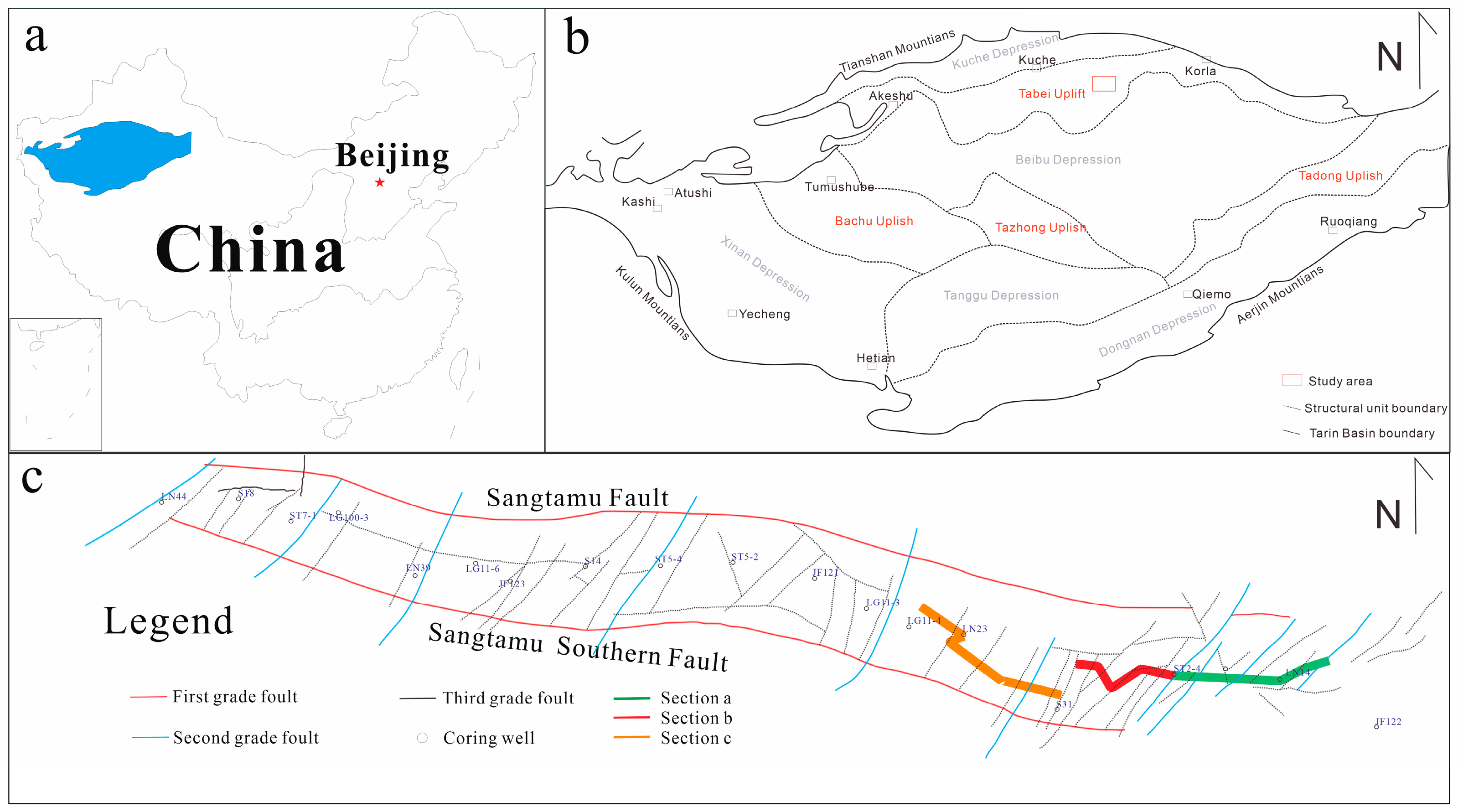
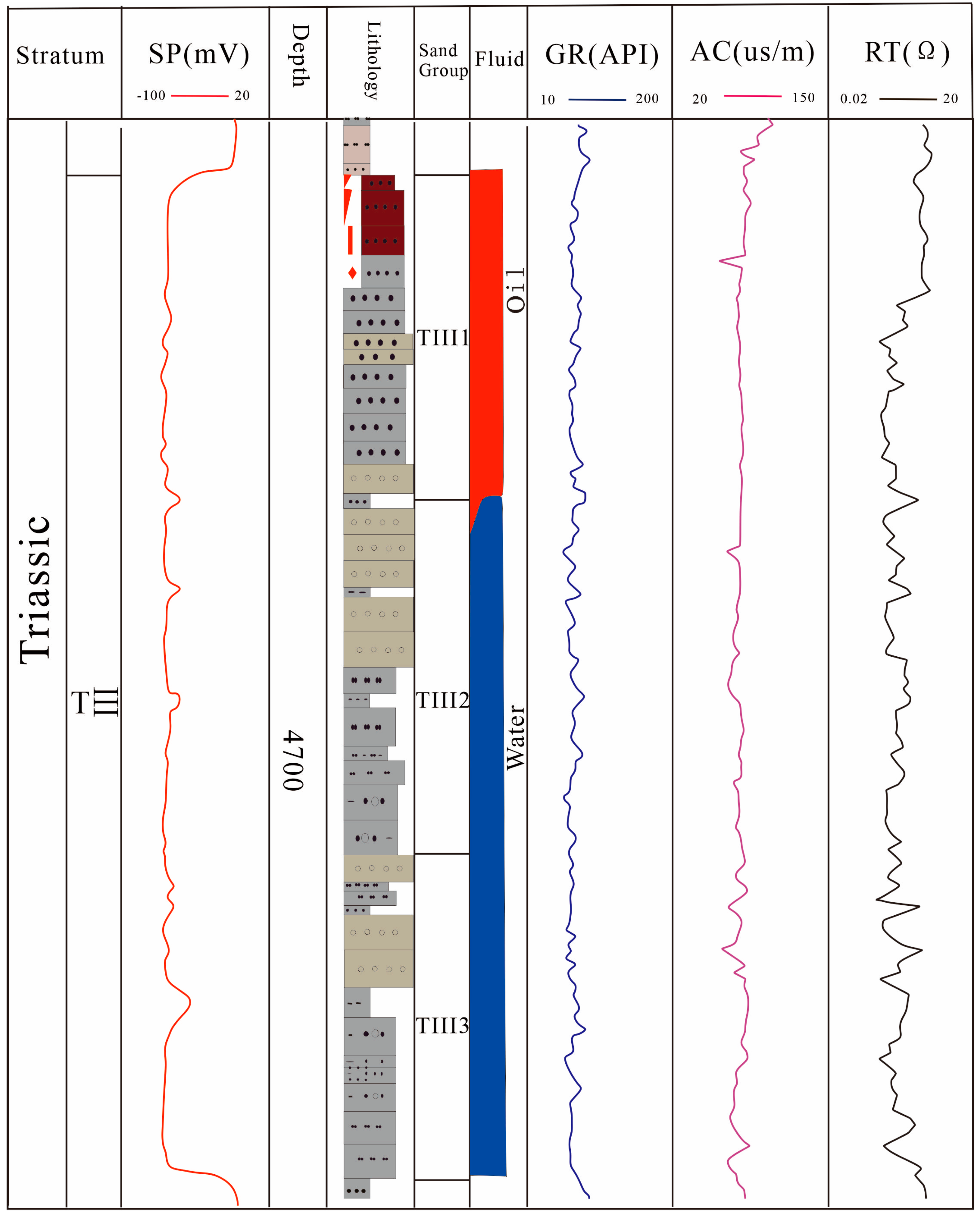

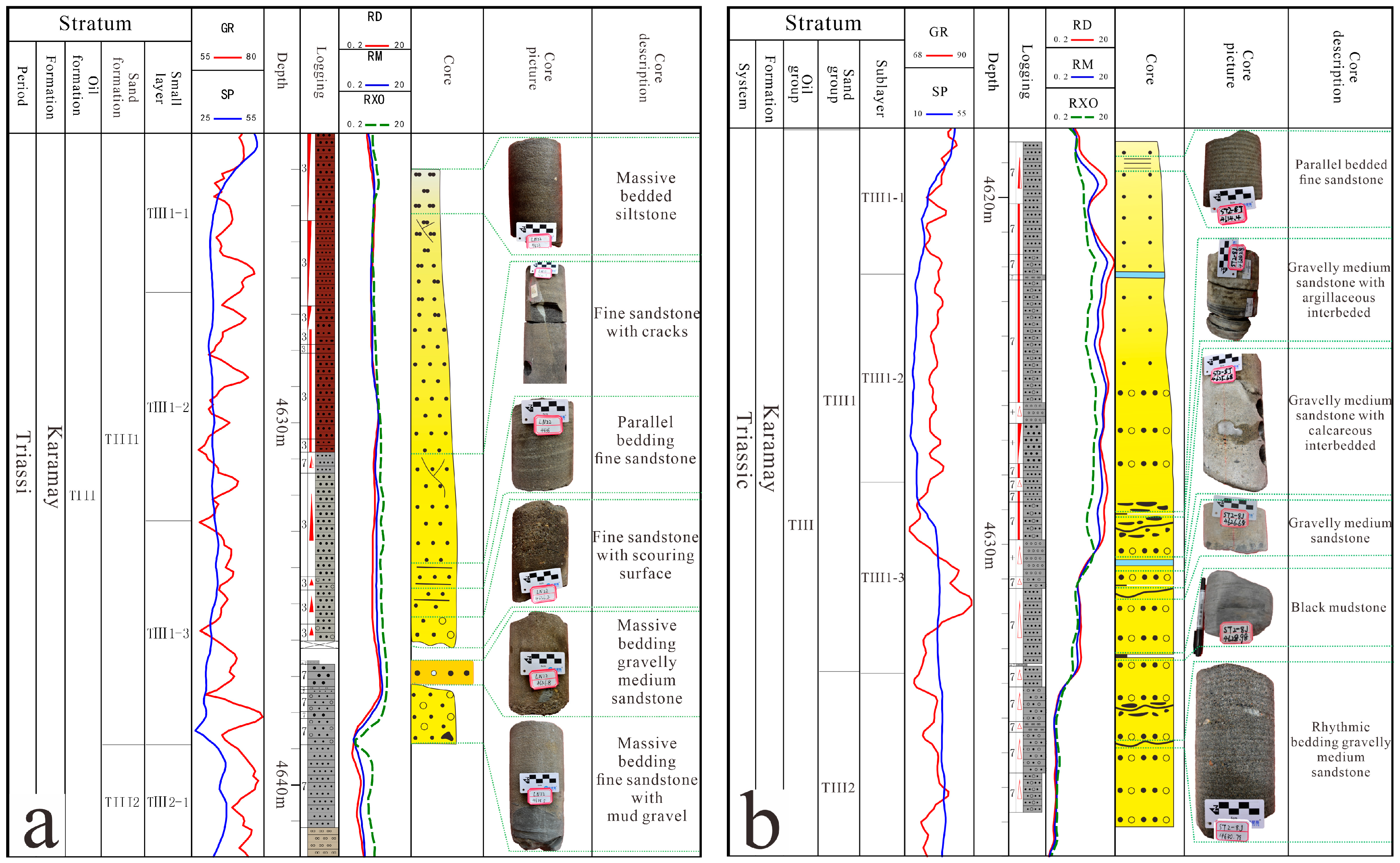
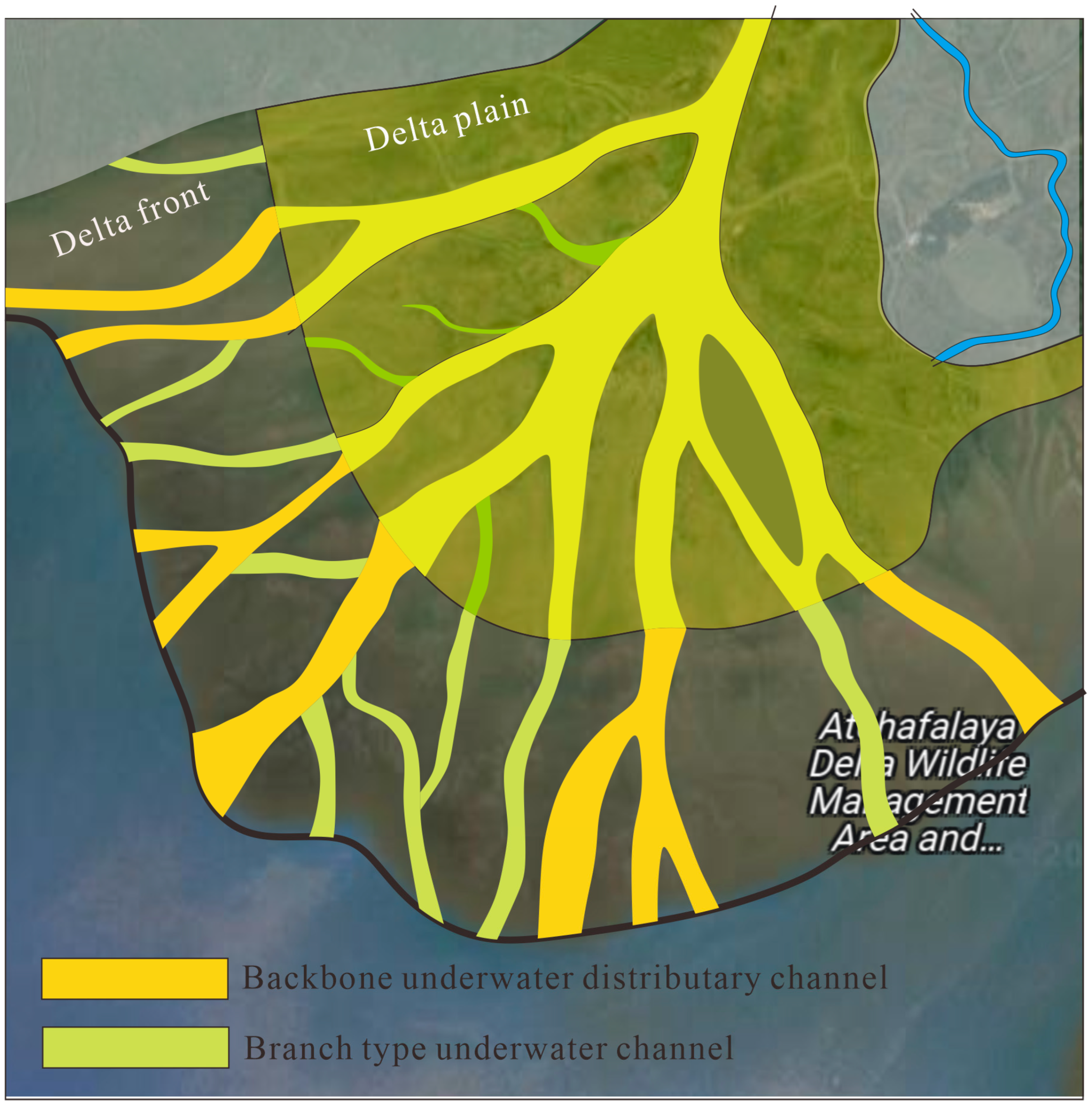
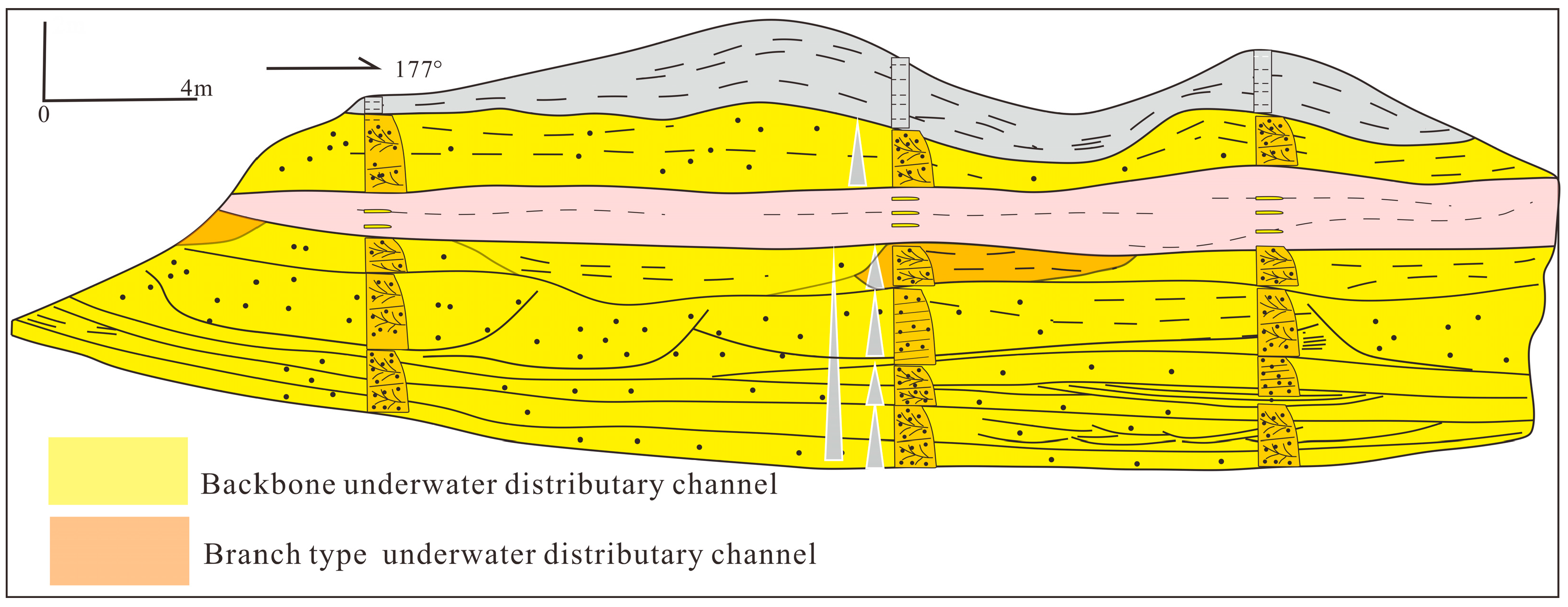


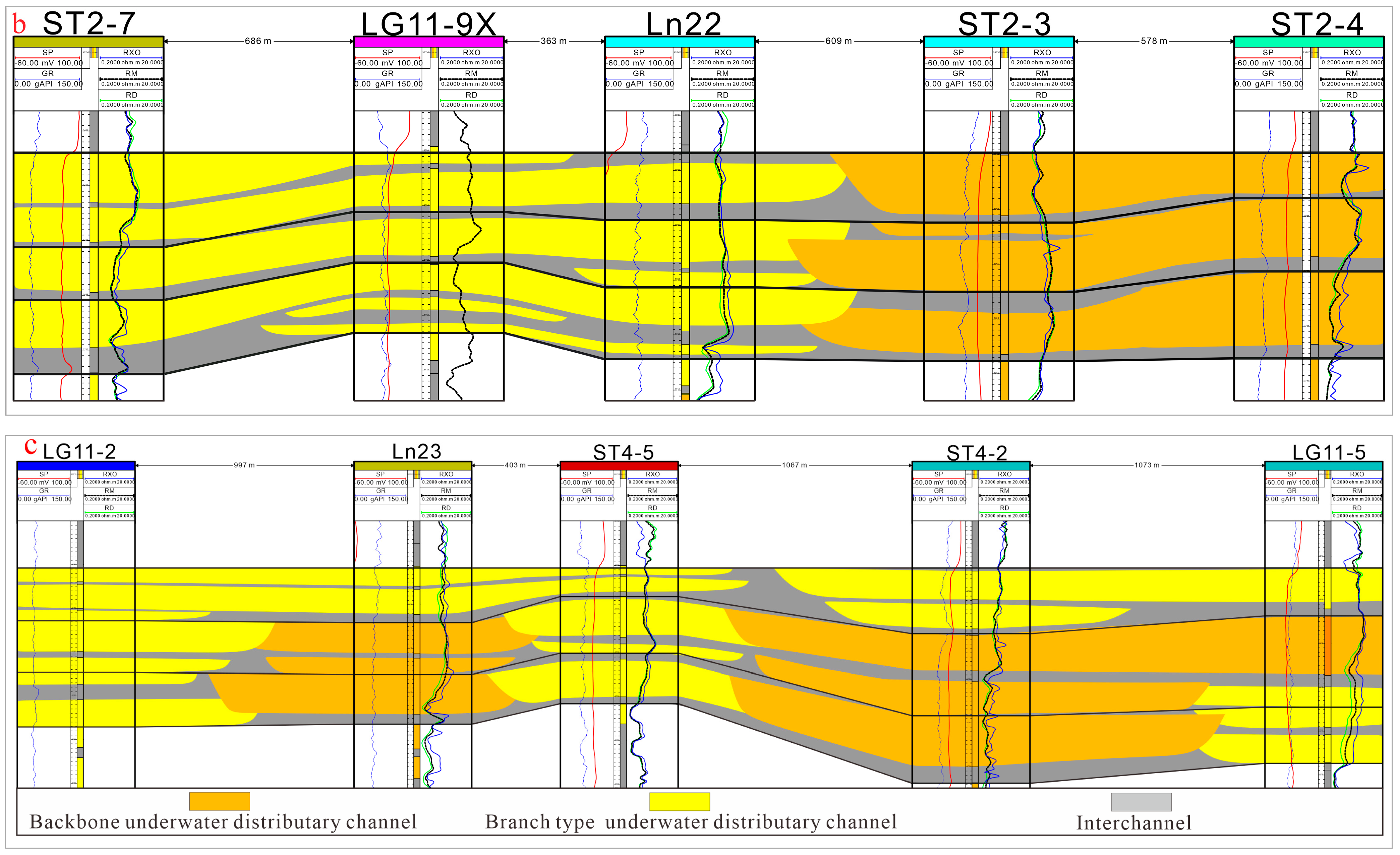




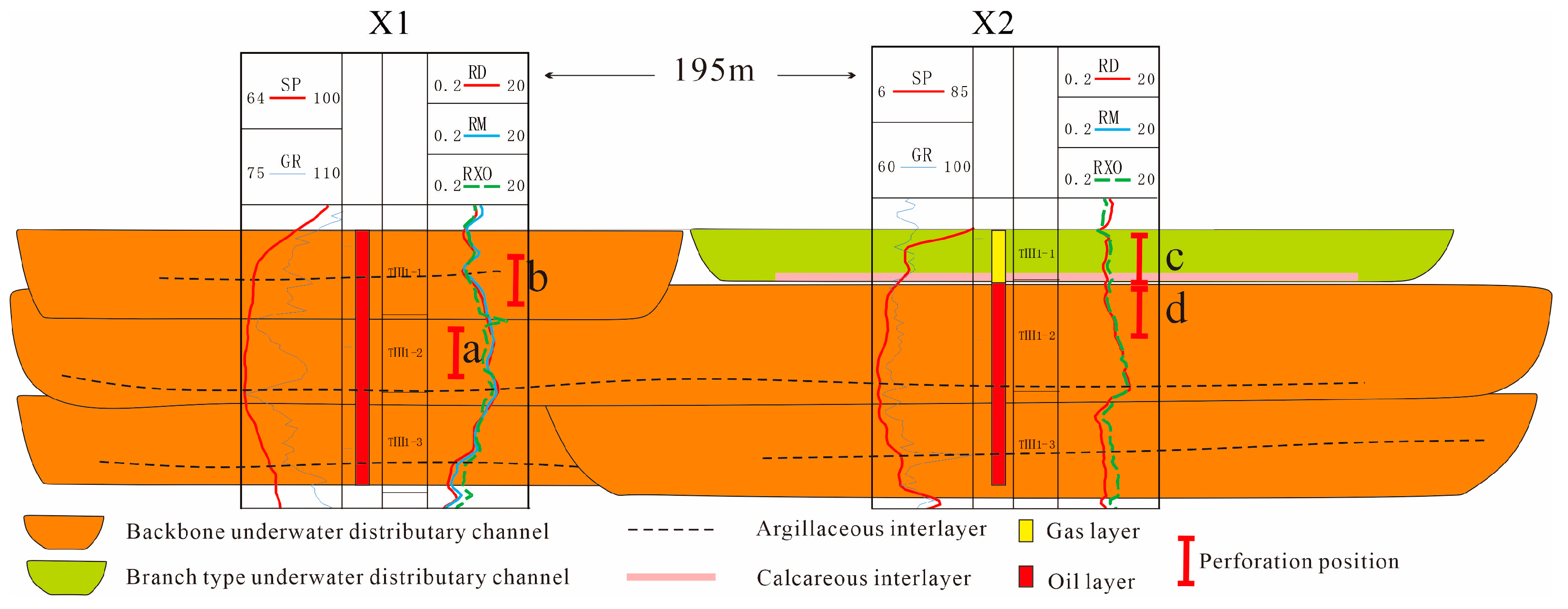
| Architecture | Particle Size and Sorting | Sedimentary Structure | Typical Logging Curve |
|---|---|---|---|
| Backbone underwater distributary channel | Medium coarse sand, containing gravel, sub round, medium sorting | Trough cross bedding, parallel bedding, massive bedding, large scour filling structure |  |
| Branch type underwater distributary channel | Medium fine sand, sub round, medium sorting | Small plate cross bedding, trough cross bedding |  |
| Interchannel | Silt, argillaceous, well sorted | Horizontal bedding, homogeneous bedding | 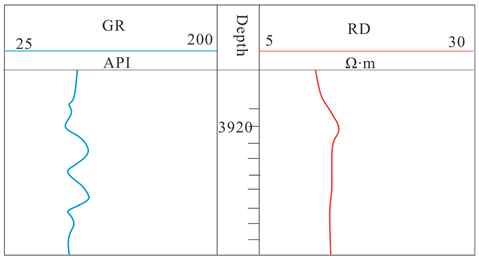 |
Disclaimer/Publisher’s Note: The statements, opinions and data contained in all publications are solely those of the individual author(s) and contributor(s) and not of MDPI and/or the editor(s). MDPI and/or the editor(s) disclaim responsibility for any injury to people or property resulting from any ideas, methods, instructions or products referred to in the content. |
© 2023 by the authors. Licensee MDPI, Basel, Switzerland. This article is an open access article distributed under the terms and conditions of the Creative Commons Attribution (CC BY) license (https://creativecommons.org/licenses/by/4.0/).
Share and Cite
Wang, C.; Yan, C.; Zhu, Z.; Li, S.; Lv, D.; Wang, X.; Liu, D. Interpretation of Sand Body Architecture in Complex Fault Block Area of Craton Basin: Case Study of TIII in Sangtamu Area, Tarim Basin. Energies 2023, 16, 3454. https://doi.org/10.3390/en16083454
Wang C, Yan C, Zhu Z, Li S, Lv D, Wang X, Liu D. Interpretation of Sand Body Architecture in Complex Fault Block Area of Craton Basin: Case Study of TIII in Sangtamu Area, Tarim Basin. Energies. 2023; 16(8):3454. https://doi.org/10.3390/en16083454
Chicago/Turabian StyleWang, Chao, Chunjing Yan, Zhengjun Zhu, Shaohua Li, Duanchuan Lv, Xixin Wang, and Dawang Liu. 2023. "Interpretation of Sand Body Architecture in Complex Fault Block Area of Craton Basin: Case Study of TIII in Sangtamu Area, Tarim Basin" Energies 16, no. 8: 3454. https://doi.org/10.3390/en16083454





